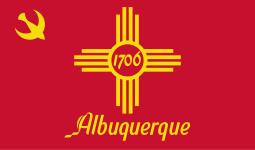Albuquerque Police Department
The Albuquerque Police Department (APD) is the largest municipal police department in New Mexico. It is located in Bernalillo County and has jurisdiction within the city limits of Albuquerque (the area immediately outside the city limits, in the unincorporated area of Bernalillo County, is policed by the Bernalillo County Sheriff's Office). In addition to their regular commissions (as City Police Officers), Albuquerque Police Officers are sworn in as special deputy sheriffs by the Bernalillo County Sheriff, which allows officers to enforce laws outside of the city limits of Albuquerque.
| Albuquerque Police Department | |
|---|---|
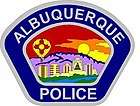 Patch | |
| Abbreviation | APD |
| Motto | "In step with our community" |
| Agency overview | |
| Formed | 1880 |
| Annual budget | $210 million (2020)[1] |
| Legal personality | Governmental: Government agency |
| Jurisdictional structure | |
| Operations jurisdiction | Albuquerque, New Mexico, U.S. |
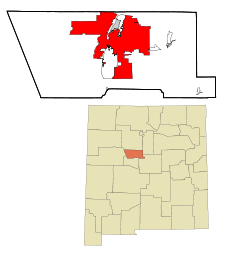 | |
| Map showing jurisdictional area | |
| Size | 181.3 sq mi (469.5 km2) |
| Population | 560,234 (2018) |
| Legal jurisdiction | As per operations jurisdiction |
| General nature | |
| Operational structure | |
| Agency executive |
|
| Bureaus | 5
|
| Facilities | |
| Area Commands | 6
|
| Helicopters | 2 – Air 1 Air 2 Eurocopter EC120 |
| Plane / Fixed Wings | 1 – Air 5 (Cessna 182) |
| Website | |
| www | |
History
Early history
The city's first police chief, J.R. Galusha, was appointed in 1916. Before that, and since 1881, the unincorporated town of Albuquerque had been patrolled by a succession of marshals,[lower-alpha 1] aided by volunteer watchmen.
1970-2000
The decade of the 1970s began for the department with the retirement of Chief Paul Shaver, the city's longest-serving police chief. Shaver had led the department for the preceding 23 years, after starting his career as a patrol officer in 1933.[4] After Shaver's retirement in June 1971, the city was rocked by rioting following the arrest of several students by police for public intoxication. The ensuing three-day melee was brought under control only after the deployment of the New Mexico National Guard. Thirteen civilians were shot during the disorder, some by police officers and some by private citizens repelling the sporadic looting that accompanied the unrest.
In 1973, the Chicano Police Officers' Association of Albuquerque and twelve Albuquerque police officers sued the city in federal court, alleging that Hispanic-surnamed applicants were discriminated against in hiring and promotion practices of the police department.[5] The lawsuit survived adverse testimony[6] and several motions to dismiss[7] and even went up to the Supreme Court of the United States[8] before being scheduled for trial in 1978.[9]
On May 15, 1978, the parties agreed to a stipulated judgment which required the city to pay $8,000 to Beserra and $8,000 to the Chicano Police Officers' Association and to meet an affirmative action goal of 34% Hispanic-surnamed people in the police department by July 1, 1981, and also to complete an affirmative action internal audit of the police department to verifiably validate the testing procedures for promotion. The department was also to assign a Chicano police officer to the police academy; and expand department language and cultural awareness training.[9] After the settlement was approved, the lawyers for the Chicano Police Officers' Association asked for more money from the city for attorney's fees, and over the dissent of Chief Judge Seth, the U.S. Tenth Circuit Court ordered them to be paid.[9] Despite the settlement, complaints continued[10] even into the 1990s.[11] However, the 34% target had been exceeded by 1993 with a 39.4% Hispanic-surnamed force.[11]
In 1976, Albuquerque police coordinated with the Federal Bureau of Investigation in Operation Fiesta. The year-long series of undercover investigations and stings, funded by the Law Enforcement Assistance Administration, targeted the fencing operations then prolific in the Albuquerque area, resulting in 79 arrests.[12]
Modern Era
Between 2010 and 2013 the number of police employed by the city of Albuquerque plummeted by more than 15% as a result of officer resignations, a drop attributed to pay cuts imposed by the city to balance a budget deficit, and low department morale.[13]
Albuquerque's police department entered an extended period of public controversy beginning in 2010 after revelations of financial impropriety in the police officers' union, and repeated high cash settlements to people sued the department for reasons from wrongful death to whistleblower harassment. In addition, the department had the highest rates of officer-involved shootings in the United States for a city its size. News that the police union had been routinely providing cash payments to officers involved in shootings to help them recover emotionally from the event, further heightened public scrutiny.[14][15][16]
In January 2010 APD officer Brett Lampiris-Tremba shot Kenneth Ellis III, an Iraq veteran threatening to commit suicide at a 7-11. Another officer shot a man who was cutting himself with a dull butter knife at the bus station downtown. Lampis-Tremba shot another man in the back in 2011, and two of his fellow officers were caught on a security camera repeatedly kicking an unarmed man in the head then doing high-fives over his body when the man lost consciousness. Then police shot a man holding a spoon standing in the doorway of his brother's house. DOJ noted that APD was especially likely to unconstitutionally use excess force against the mentally ill and citizens too intoxicated or developmentally impaired to comply with officers' orders.[17]
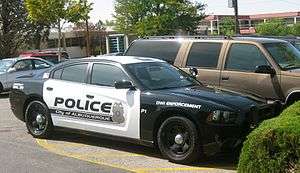
In November 2012, a union-sponsored survey of Albuquerque police officers found that all but 3 of the 456 department personnel who responded to the questionnaire characterized morale as "low," with 18% saying the U.S. Department of Justice should be asked to initiate an inquiry into the department.[18] The Department of Justice did launch a civil investigation of the Albuquerque Police Department later that month.[19][20]
The DoJ investigation found APD engaged "in a pattern or practice of violating residents' Fourth Amendment rights" and of using deadly force "in an unconstitutional manner". It called for an extensive series of reforms.[21]
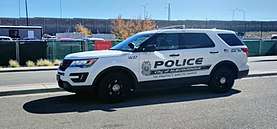
Prior to the DoJ report, a survey by Albuquerque's KOAT-TV found that 42% of the city's residents trusted police, 22% distrusted them, and the remainder "fell somewhere in the middle." City council member Rey Garduño characterized these results as "not good". Mayor Richard J. Berry said he continued to "stand behind" the police department.[22]
In February 2014, Gorden Eden replaced outgoing chief Ray Schultz, who stepped down due to ongoing controversy.[23][24] In March 2014, approximately 300 Albuquerque residents protested against police in a tumultuous demonstration that ended with tear gas being deployed amid scattered clashes between police and protesters. Mayor Berry said the protest was sidelined by a small group within the larger demonstration that was determined to create havoc.[25][26] A counter-protest the following week drew a crowd of several hundred in support of the police.[27]
On May 3, police shot and killed Armand Martin following a six-hour standoff between police and Martin, whose wife had called 911 after Martin allegedly stated an intention to kill his children. According to police, officers opened fire after Martin exited his home shooting wildly at nearby houses with two handguns.[28] Two days later, in response to the shooting, several dozen protesters—led by activists Andres Valdez and David Correia—descended on Albuquerque city council chambers, presenting a self-styled "arrest warrant" for Chief Gordon Eden and forcing the premature adjournment of the council meeting.[29] Valdez subsequently declared he and protesters had successfully deposed the city government in a coup d'état, although the council reconvened normally two days later.[30]
Correia, a University of New Mexico professor, said he got the idea to attempt a "citizen's arrest" of officials from the 1967 Reies Tijerina courthouse raid, an incident in which protesters supporting land redistribution stormed a courthouse, gunned down police who attempted to resist the takeover, and took the sheriff and a journalist hostage.[31]
Death of Christopher Torres
On April 12, 2011, two Albuquerque Police Department Police Officers in civilian clothing hopped a fence into the backyard of Christopher Torres, who was schizophrenic, in an attempt to serve a warrant. An Officer by the name of Christopher J. Brown shot him to death that day. A witness to this shooting described the situation as appearing to be men, the police officers, she later discovered, trying to rob Christopher Torres. Stephen Torres, the father of Christopher Torres, won a lawsuit against APD in the case of his son whose death resulted from excessive force. Author Rachel Aviv wrote an article for the New Yorker about the shooting.[32]
Department of Justice investigation
In November 2012, the United States Department of Justice (DOJ) launched an investigation into APD's policies and practices to determine whether APD engages in a pattern or practice of use of excessive force in violation of the Fourth Amendment and the Violent Crime Control and Law Enforcement Act of 1994, 42 U.S.C. § 14141 (“Section 14141”).[33] As part of its investigation, the Department of Justice consulted with police practices experts and conducted a comprehensive assessment of officers’ use of force and APD policies and operations. The investigation included tours of APD facilities and area commands; interviews with Albuquerque officials, APD command staff, supervisors, and police officers; a review of numerous documents; and meetings with the Albuquerque Police Officers Association, residents, community groups, and other stakeholders.[33]
At the conclusion of its investigation, the DoJ issued a scathing report that uncovered a "culture of acceptance of the use of excessive force", frequently not justified by the circumstances, causing significant harm or injury by APD officers to people who posed no threat. The DOJ recommended a nearly complete overhaul of the department's use-of-force policies. Among several systematic problems at APD were an aggressive culture that undervalued civilian safety and discounted the importance of crisis intervention.[34]
As result of the report the city and the DOJ negotiated a court-enforceable agreement, which included among its 106 pages provisions to dismantle the Repeat Offender Project and rein in the SWAT team, which had operated outside the command structure for years.[35]
An April 2016 Fault Lines article, cited Al Jazeera interviews with former officers, local lawyers and journalists who stated that change was only scratching the surface and that the corrupt and violent culture of the police department continued unabated.[36]
Death of James Boyd
On January 12, 2015, two Albuquerque PD officers, Keith Sandy and Dominique Perez, were charged with open counts of murder in the shooting death of James Boyd, a mentally ill homeless man who was illegally camping on the Sandia Mountains foothills on March 16, 2014.[37] Boyd was carrying two camping knives in his hands and was shot three times, in the back and both arms, from at least ten feet away with a semi-automatic rifle after a five-hour standoff. Officers also fired a Taser shotgun and a beanbag shotgun at Boyd, while another officers threw a flash-bang grenade. The video also shows one officer unleashing his K-9 German shepherd against Boyd as he lay on the ground wheezing. The standoff was captured on body mounted cameras.[38] Boyd died later at UNM Hospital. The death of Boyd led to protests in Albuquerque against the excessive force. The APD was also sued by Boyd's brother, alleging wrongful death. In July 2015, the city of Albuquerque agreed to pay $5 million to Boyd's family.[39]
Shooting of Detective Jacob Grant
In January 2015, an Albuquerque undercover detective was shot by another officer. During a drug investigation, Lieutenant Greg Brachle approached a car. When Detective Jacob Grant, who was undercover in the back of the car, began to roll down the window, the lieutenant shot him nine times in a case of mistaken identity. Brachle faced no charges and was allowed to retire. Grant survived his wounds.[40]
Fatal shootings since 2010 to mid-2014
- 1/9/10: Officer Andrew Cooke shoots Aaron Renfro.
- 1/13/10: Detective Brett Lampiris-Tremba shoots Kenneth Ellis III.
- 3/29/10: Officer Kevin Sanchez shoots Mickey Owings.
- 6/10/10: Officers Anthony Brown, Eric Sedler shoot Chris Hinz.
- 6/14/10: Officer Aaron Zwicky shoots Julian Calbert.
- 7/27/10: Officer Jeremy Hollier shoots Len Fuentes.
- 8/17/10: Officer Josh Brown shoots Enrique Carrasco.
- 10/19/10: Officers Drew Bader, Ramon Ornelas shoot Daniel Gonzales.
- 10/31/10: Officer David Sprague shoots Alexei Sinkevitch.
- 2/9/11: Detective Byron “Trey” Economidy shoots Jacob Mitschelen.
- 4/12/11: Officer Christopher J. Brown shoots Christopher Torres.
- 5/10/11: Officer Sean Wallace shoots Alan Gomez.
- 6/4/11: Officer Matthew Oates shoots Raymond Garcia.
- 8/30/11: Officer Jim Perdue shoots Michael Marquez.
- 1/4/12: Officer Mario Perez shoots Mark Macoldowna.
- 3/19/12: Officer Martin Smith shoots Daniel Tillison.
- 3/21/12: Officer Russ Carter shoots Gary Atencio.
- 3/5/13: Officers Perdue, Sedler and Aragon shoot Parrish Dennison.
- 3/19/13: APD shot at Kendall Carroll, but he was killed by State Police.
- 7/5/13: Officers Jeff Bludworth and Katherine Wright shoot Vincent Wood.
- 10/26/13: Officer Luke McPeek and others shoot Christopher Chase.
- 12/8/13: Officer Hector Marquez shoots Andy Snider.
- 3/16/14: Detective Keith Sandy and Officer Dominique Perez shoot and kill James Boyd.
- 3/25/14: Officer James Eichel fatally shoots Alfred Redwine[41][42]
- 4/21/14: Officer Jeremy Dear shoots and kills Mary Hawkes
- 5/3/14: Officer Daniel Hughes shoots and kills Armand Martin
- 5/22/14: Officers Ryan Graves and Brian Fuchs shoot and kill Ralph Chavez
- 7/22/14: Officers Anthony Sedler and Ramon Ornelas shoot and kill Jeremy Robertson[42]
Consent Decree
The monitor in a November 1, 2016, report questioned whether the police department had read his previous reports, and suggested a formal system to assess, react to and implement his findings.[43] According to the police oversight board, citizens made 125 formal complaints in the first half of 2016.[44] The board also said October 20 that the police chief is not following the procedure agreed to in the consent decree for responding to the board's recommendations on officer discipline in use of force incidents. The police chief was previously not required to respond to the recommendations, but since the settlement agreement the police chief is supposed to reply outlining his rationale when he disagrees with the board's recommendations.[45]
Rank structure
-
| Title | Insignia |
|---|---|
| Chief of Police | |
| Deputy Chief of Police | |
| Chief of Staff | |
| Deputy Chief of Staff | |
| Commander | |
| Lieutenant | |
| Sergeant | |
| Police Officer/Detective | |
Operations
The Albuquerque Police Department currently holds 839 sworn officers and is currently budgeted for 1,000 commissioned law enforcement officers, who operate out of six area commands. An air unit operates a Eurocopter EC120, and a Cessna 182. Many legislatures on both sides of the political spectrum are advocating for increased recruitment in hopes of obtaining 1,000+ sworn officers. The Albuquerque city budget for 2018 is set in place currently to raise officers pay by 2-3% in hopes of retaining experienced officers.[46]
In September 2008 the Bureau of Statistics the US Department of Justice reported that the Albuquerque Police Department was the 49th largest police department in the United States.[47] The crime rate in Albuquerque is 53% higher than the U.S. average, with notably high levels of drunk driving and gun violence.[48]
In popular culture
The Albuquerque police department and fictional Albuquerque police officers are portrayed at various times in the television series Breaking Bad and its spin-off prequel Better Call Saul, which are set in a version of the city.
In the late 1990s and early 2000s, the department appeared in several episodes of the television show Cops. However, beginning in 2001 Mayor Martin Chávez refused to allow the program to shoot additional episodes, explaining that "the city's police officers are portrayed in a good light, but the rest of the city looks horrible." A newspaper report on the Cops ban at the time noted a post made to a television enthusiast website commented "How much crime can there be in Albuquerque, New Mexico? They taped so many shows in that town, I'm ready never to visit."[49] In 2014, the mayor's office reiterated its refusal to allow the television show access to the city police.[50]
In Plain Sight (2008-2012) is a series that revolves around officers attached to the Albuquerque, NM, office of the Federal Witness Security Program (WITSEC). One character is an APD detective.
APD came under heavy fire in two articles in early 2015, one in Rolling Stone[37] and one in The New Yorker.[32] Both articles lambasted the Police Department for use of force and lack of accountability in officer involved-shootings. Despite the Albuquerque Police Department paying one of the highest starting salaries in the state and nation, the department is still struggling to obtain above 1,000 officers.
See also
Notes
- Albuquerque's first Marshall, Milton J. Yarberry, was hanged for murder.
References
- Sullivan, Carl; Baranauckas, Carla (June 26, 2020). "Here's how much money goes to police departments in largest cities across the U.S." USA Today. Archived from the original on July 14, 2020.
- "Executive Staff". The City of Albuquerque. 2017-12-03. Retrieved 2017-12-03.
- http://www.cabq.gov/police/our-department
- "Albuquerque Police Department Museum". cabq.gov. City of Albuquerque. Retrieved 7 May 2014.
- Cohea, Carol (21 July 1973) "Chicano Police File Suit" The Albuquerque Journal page 1, column 4
- Cohea, Carol (1 December 1973) "Defense Consultant Denies Tests Unfair to Chicano Police Group" The Albuquerque Journal page 5, column 1
- Staff (21 November 1975) "New Trial Ordered" The Albuquerque Journal page 4, column 4
- Stover v. Chicano Police Officers Ass'n, 426 U.S. 944 (1976)
- For case history see: Chicano Police Officer's Association v. Beserra, 624 F.2d 127 (1980 Tenth Circuit, opinion by Judge Logan)
- Staff (9 September 1979) "Chicanos Allege Bias" The New Mexican page 15, column 3
- Associated Press (13 April 1993) "Group challenges hiring practices of Albuquerque Police Department" The New Mexican page 8, column 1
- "FBI Albuquerque Division- A Brief History". fbi.gov. FBI. Archived from the original on 21 April 2014. Retrieved 7 May 2014.
- Dan McKay (August 18, 2014). "APD shrinking; Berry reveals incentive plan". Albuquerque Journal. Retrieved May 7, 2014.
- Michael Haederle (14 April 2012). "In Albuquerque, an uproar over shootings by police". LA Times. Retrieved 31 March 2014.
- Jeri Clausing (2012-03-23). "Albuquerque Police Were Paid 'Bounty' For Shootings Claims Victim's Father Mike Gomez". Retrieved 2014-03-31.
- Manny Fernandez and Dan Frosch (March 24, 2012). "Payments to Albuquerque Officers Are Called a 'Bounty System'". Retrieved March 31, 2014.
- David Correia (January 13, 2014). "Life and Death and APD: The problem of police violence in Albuquerque". Alibi.
- Proctor, Jeff (14 November 2012). "Survey: APD Officers Say Morale Low". Albuquerque Journal.
- Office of Public Affairs (2012-11-27). "Justice Department Launches Investigation of the Albuquerque, N.M., Police Department's Use of Force". The United States Department of Justice. Retrieved 2014-03-31.
- Dan Frosch (November 27, 2012). "Justice Dept. to Investigate the Police in Albuquerque". Retrieved March 31, 2014.
- Santos, Fernanda (10 April 2014). "Excessive Force Common for Albuquerque Police, Justice Dept. Finds". The New York Times.
- "Survey: 42 percent of residents trust police". KOA-TV. 10 April 2014.
- "New Mexico: Police Chief Chosen for Embattled Albuquerque Force". New York Times. Associated Press. February 14, 2014.
- http://www.abqjournal.com/352961/news/3-left-in-running-for-chief-of-apd.html
- Nottingham, Shawn (1 April 2014). "In Albuquerque, protesters clash with police". CNN.
- Hughes, Trevor (31 March 2014). "Albuquerque police face hundreds of protesters". USA Today.
- Da, Royale (7 April 2014). "Albuquerque police face hundreds of protesters". KOAT-TV.
- Miller, Cole (5 May 2014). "Photos, 911 call released in latest APD shooting". KRQE-TV. Archived from the original on 2014-05-08.
- Jennings, Trip (5 May 2014). "New Mexico: New Protests Against Albuquerque Police". New York Times.
- Contreras, Russell (8 May 2014). "Police shootings: Albuquerque council meets". chron.com. Houston, Texas: Houston Chronicle.
- "Albuquerque council meets amid heightened security". USA Today. 9 May 2014. Retrieved 9 May 2014.
- Aviv, Rachel (2 February 2015). "Your Son Is Deceased". The New Yorker. Retrieved 2015-04-28.
- "United States V. City Of Albuquerque" (PDF). U.S. Department Of Justice. Retrieved 4 May 2015.
- Gallagher, Mike (April 11, 2014). "Scathing Report on APD Use of Force". Albuquerque Journal. Retrieved April 16, 2016.
- Jeff Proctor (October 31, 2014). "APD specialized squads, Internal Affairs getting overhaul in DOJ consent decree". KRQE. Archived from the original on 2016-11-11. Retrieved November 11, 2016.
- "Albuquerque Police: A History of Violence". Fault Lines. Al Jazeera English. April 13, 2016. Retrieved April 16, 2016.
- Pinto, Nick (January 29, 2015). "When Cops Break Bad: Inside a Police Force Gone Wild". Rolling Stone. Retrieved April 28, 2015.
- Fitzpatrick, David. "Officers face murder charges in 2014 Albuquerque homeless man's shooting". CNN. Retrieved 28 April 2015.
- Boetel, Ryan (July 10, 2015). "City settles Boyd shooting case for $5 million". Albuquerque Journal. Retrieved April 16, 2016.
- Bult, Laura (April 1, 2016). "Shocking police video shows moment undercover Albuquerque cop was shot nine times by fellow officer: 'I thought you were a bad guy!'". NY Daily News. Retrieved April 16, 2016.
- http://www.abqjournal.com/374422/abqnewsseeker/apd-chief-suspect-in-hospital-after-officers-fire-at-him-2.html
- "APD Under Fire". Albuquerque Journal.
- Matt Grubs (November 1, 2016). "Albuquerque Police Department monitor says police at 'critical crossroads' in reform effort: Department still fails to get use-of-force review right, independent reviewer warns". KRQE.
- "Civilian Police Oversight Agency shows new numbers on APD complaints". KRQE. October 11, 2016.
- Chris McKee (October 20, 2016). "Oversight group claims APD Chief not following officer discipline explanation rules". KRQE. Retrieved November 11, 2016.
- http://documents.cabq.gov/budget/fy-18-approved-budget.pdf
- U.S. Department of Justice. "Census of State and Local Law Enforcement Agencies, 2008" (PDF). Retrieved 2014-03-31.
- "Albuquerque Really Is Like Breaking Bad". TIME. 27 September 2013. Retrieved 9 May 2014.
- Potts, Leanne (25 January 2004). "Mayor Has Banned 'Cops' in Albuquerque". Albuquerque Journal.
- "Television show 'Cops' returns to Albuquerque area". msn.com. Associated Press. Archived from the original on May 12, 2014. Retrieved 9 May 2014.
External links
- Albuquerque Police Department Website
- APD Forward, that oversees the implementation of the agreement between the Department of Justice & APD
- APD Findings Letter
- Albuquerque Settlement Agreement
- List of Incident Summaries
- An article by David Correia, a scholar from Albuquerque, describing more details from the incidents above.
